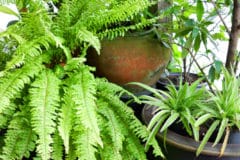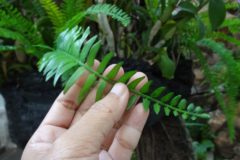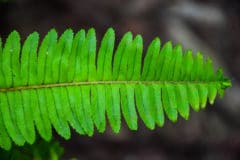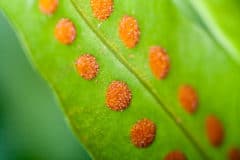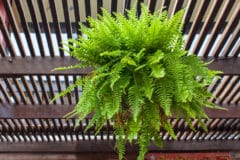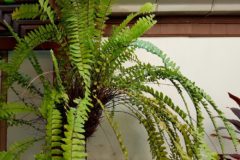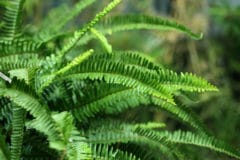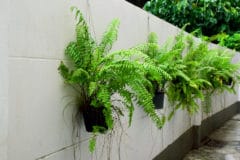About the Boston Fern
Boston fern is a cultivar of a Florida native, the sword fern Nephrolepis exaltata. Its gracefully arching fronds make it a natural for hanging baskets or a plant stand. A perennial that is hardy in USDA Zones 9 to 11, it can be grown outdoors in those regions. Many people who live in colder regions also move it outdoors in the summer.
Soil for a Boston Fern
As long as the soil drains well, Boston fern is quite tolerant of different potting mixes. You can use a commercial mix or make your own by combining equal parts of garden soil, peat moss and builder’s sand. A soilless potting mix is another option. Commercial mixes are readily available. Make your own with equal parts peat moss or coconut coir, perlite or vermiculite, and sand or bark.
Water for a Boston Fern
Like Goldilocks, Boston ferns need “just right” watering. Too much increases the potential for rot, too little can kill the plant. Water the plant with room temperature water until water runs out the drain holes. Do not water again until the soil surface feels dry or the pot seems very light. The exact watering interval will vary with your home’s condition and the season (keep it drier in winter).
Humidity and the Boston Fern
Native to the humid climate of Florida, Boston ferns may suffer in a dry indoor environment, especially in the winter. Place pots on a shallow tray that contains pebbles and fill the tray with water. You can also mist the plant several times a day. Use room temperature water to avoid shocking the plant. Don’t water more unless the soil is obviously dry or you may encourage rot.
Best Light for Boston Fern
In the wild, Boston fern’s ancestors grew on the forest floor in dappled shade. Mimic these conditions indoors, with bright indirect light. The fern will do well in a west- or south-facing window if you pull a blind during periods when the sun shines directly on the plant. However, in winter, they will probably require full sun. You can also supplement with grow lights.
Boston Fern Insect Problems
Mealy bugs, mites, thrips, aphids, whiteflies, snails, slugs and nematodes are the most likely insect pests. However, most of these are a problem outdoors rather than inside. To control:
- Insecticidal soap will take care of most of these (spray tops and bottoms of fronds thoroughly).
- A strong jet of water can dislodge aphids.
- Snails and slugs can be handpicked.
- Interplanting with marigolds will deter nematodes.
Growing Boston Fern Outdoors
Boston fern can be grown outdoors year round in warmer climates. Sometimes in a colder winter, the fern may die back to the roots. In dry areas, you’ll need to increase the humidity by more frequent watering (make sure soil drains well) or sprinkling the plants periodically. The plant will do better in dappled shade. You can usually put a Boston fern outside for the summer in any climate.
Propagating Boston Fern From Runners
Boston fern sends out stolons, or runners, in much the same manner as Bermuda grass. Once the stolon has developed some roots, break it loose it from the mother plant and plant it in sterilized potting soil. You can also plant stolons without roots, but they will take longer to develop. Water lightly, cover with a plastic bag and keep at 60°F (16°C) to 70°F (21°C).
Dividing Boston Fern
Boston fern is easily divided. Allow the roots to dry out slightly. Remove the plant from its pot and slice into eights with a serrated knife. Trim each section to a diameter of one to two inches. Trim the roots to between one-and-a-half and two inches. Plant each division in a four or five inch pot (you can remove sickly fronds) and keep moist but not wet.

